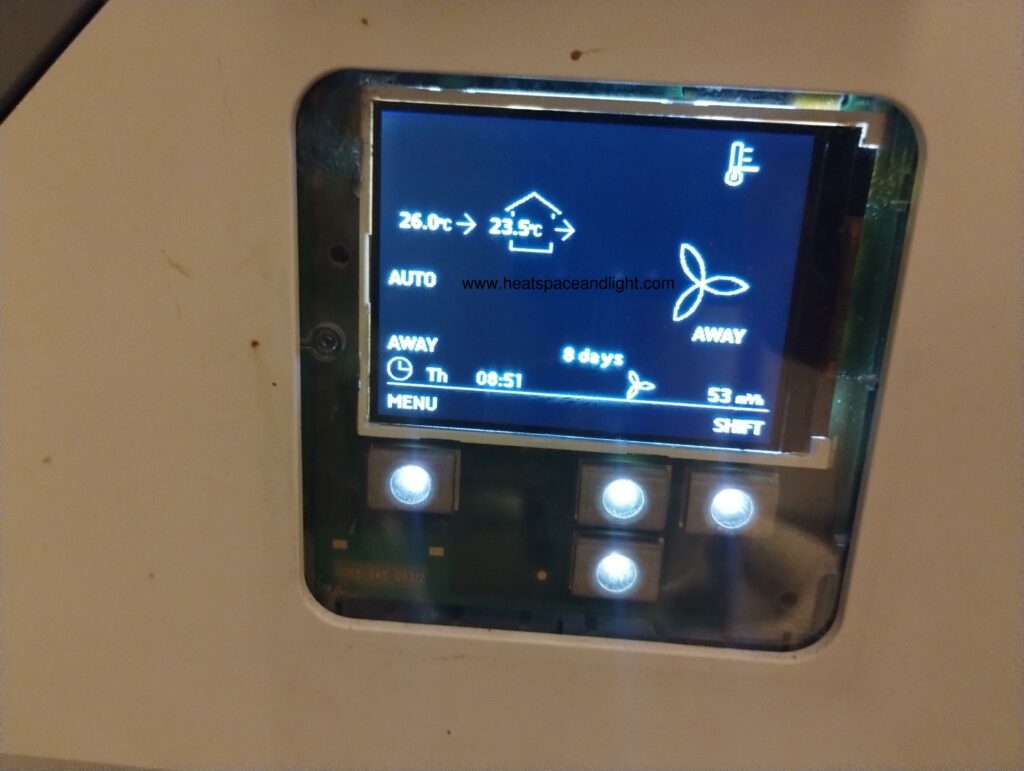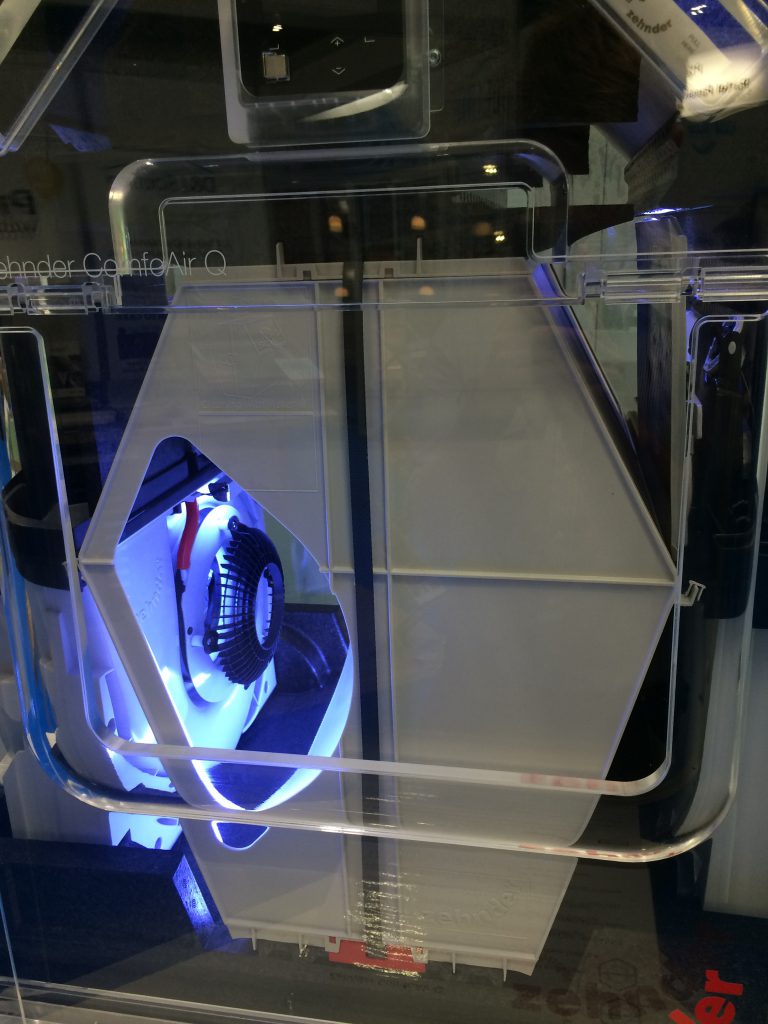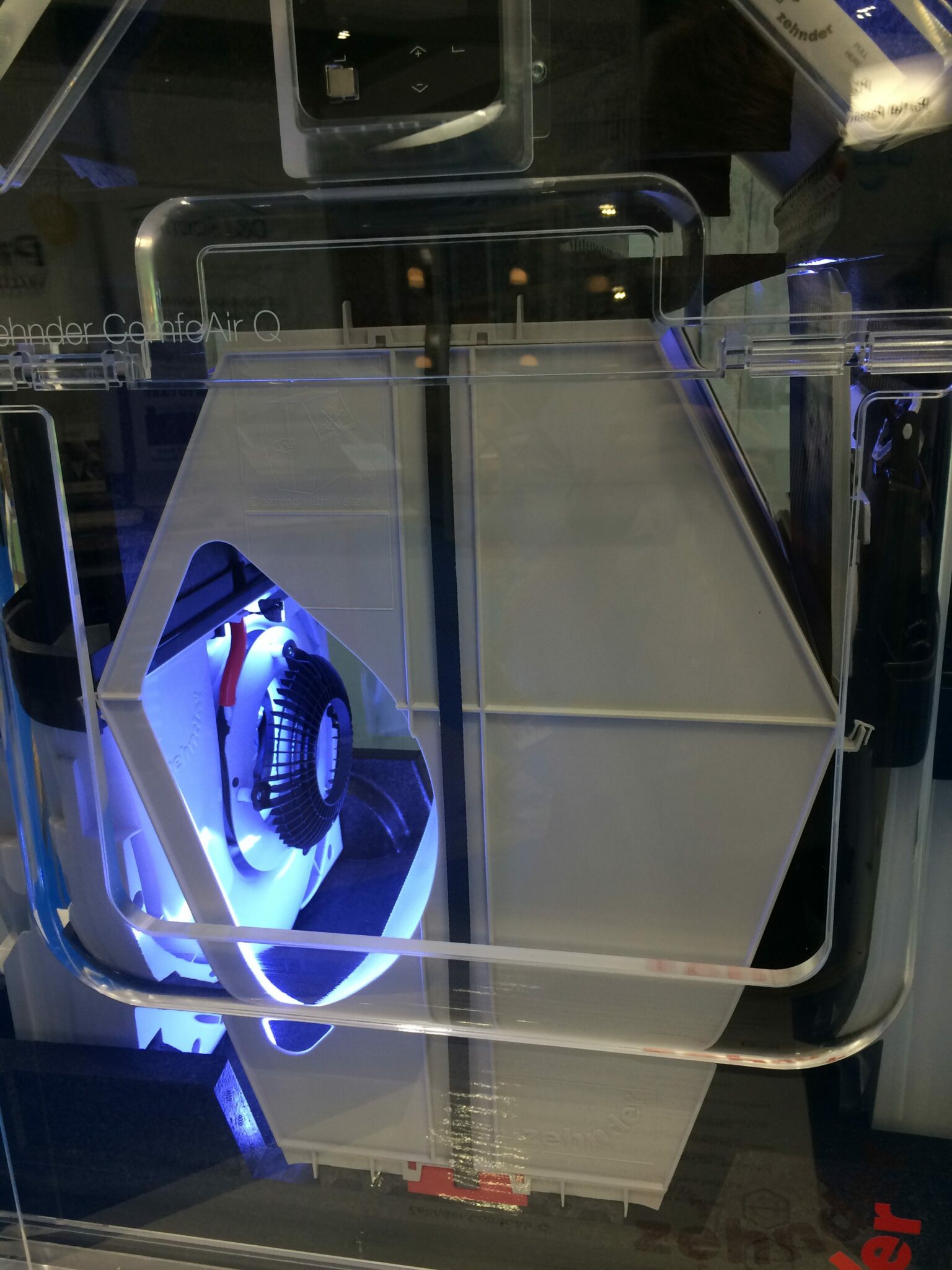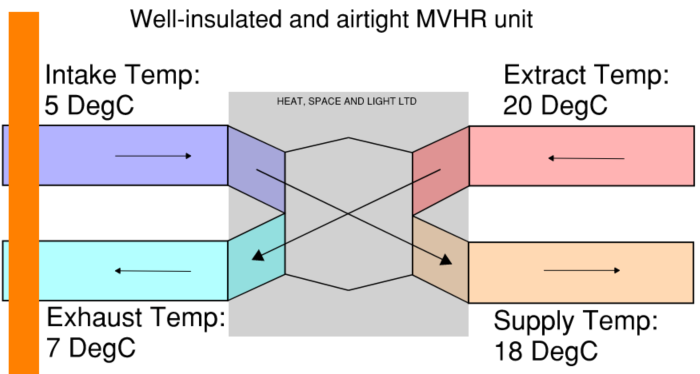Can an MVHR system help to cool your home in summer?
Yes, a Mechanical Ventilation with Heat Recovery system (MVHR) can help to cool your home in summer, and it does it in a way that is quiet and automatic, using only the energy equivalent of two LED lightbulbs.
This is the control panel of an MVHR system installed in a low energy retrofit on a hot summer’s day. What the readings show is that it’s 26 DegC outdoors (ie, a hot day), but because the home is cooler, the MVHR system is actually using this cooler air to cool the incoming air. That means healthy levels of fresh, filtered air is also being cooled.

Compared to an Air-Conditioning (AC) system, an MVHR is nowhere near as powerful at cooling, but an AC system also some has significant issues attached to it (mainly high energy use, cost, noise and health).
This article will provide some key points to decide if you should choose an MVHR or an AC system (or both) for your home to help with cooling in summer.
How can an MVHR be reversed to cool?
In order to explain how an MVHR system helps to cool a home in summer, we have to look at how it heats a home in winter.
All year round we have a need for ventilation in the home – even in summer, when we may still need to keep the windows and doors closed for security, noise and pollen/hayfever issues. The MVHR fans are therefore always running at low level and for the equivalent of a few pence per day.
In winter, the MVHR is extracting warm, humid air from bathrooms, kitchens and utility rooms and passing the heat to the cold incoming air from outside. This airflow exchange is done at a rate that removes CO2, VOCs and excessive humidity and means the incoming air is pre-heated.
In summer however, if it’s warm inside and outside we don’t want to recover the extract heat to push it back into the home. The “smarter” MVHR systems will detect this and will automatically shift to “Summer Bypass Mode“. The warm, humid air from bathrooms, kitchens and utility rooms is exhausted straight outside, bypassing the exchanger, and the incoming air is filtered straight inside.

Part of the indoor heat removed is from AV/computer/lighting systems and hot water tanks that would otherwise be contributing to excess heat in the home all through summer.
Never buy an MVHR that does not include proper automated Summer Bypass Mode.
Getting rid of humid indoor air makes us feel cooler
It’s important for indoor cooling that warm, humid air is removed from the home, because excessively high humidity is a factor in what makes us feel hotter. By reducing the Relative Humidity (RH) of the indoor air, we can tolerate slightly higher temperatures, so an MVHR removing humid air will drive down the RH and create a more comfortable indoor environment.
On cool summer nights without wind the MVHR is still ventilating
During the day the incoming air from the MVHR won’t make any difference to the indoor air temperature, but as temperatures cool in the evenings (as they do in the UK) the MVHR will still be bringing in this cooler night-time air, and this helps cool the home overnight – especially when sleeping.
This is a bonus compared to just leaving the windows open, as there’s no guarantee there will be any wind to carry the cooler air into the home anyway (and often summer nights are still and devoid of wind).
How does an MVHR compare to Air-Conditioning?
An MVHR system can’t recreate the power and intensity of the cooling from an AC system. Whereas an AC system can blast in cold air into a room and lower it to 16 DegC within a few minutes, an MVHR moves the air much more slowly. This is deliberate, as an MVHR is designed to ventilate near-silently and over 24 hours. An AC is designed to react instantly, and for shorter periods of time.
If you’ve every slept in a hotel room with an AC system that clunks and drips and hums all night, the difference in acoustics between AC and an MVHR is clear.
Should I get an MVHR or an AC system to deal with cooling?
All modern homes should be considering an MVHR system for their ventilation, as it is the cornerstone to an energy efficient, comfortable and healthy home in the 21st Century.
But the question is: at what point a home needs active cooling such as AC, rather than just relying on opening windows, running the MVHR or desk fans? AC is expensive and noisy and space has to be found indoors and outdoors for it, so it has to be considered very carefully before installed.
In the UK we haven’t traditionally tended to use air-conditioning systems in our homes, but our company is now more often seeing AC installed strategically in our MVHR projects in places where the risk of overheating is highest – typically lofts and ground floor rooms with lots of south-facing glazing.
CIBSE has also produced its own guidance on thermal comfort and how to build for it, but it’s behind a paywall to non-members sadly. It says everything I mention in this blog.
MVHRs can also incorporate cooling into their supply air, if they are linked to a reversible heat pump, or as a standalone cooling unit. Please contact us if you would like a sizing and specification proposal for an MVHR with cooling for your project.
The decision to install active cooling (eg, AC) will depend on the risk of overheating to the home. Although every home is different, there are certain aspects of a building that will increase the risk of overheating. I’ve explained why homes overheat in more detail in this article.
What aspects of a building increase overheating risk
Rooms with lots of unshaded south-facing glazing, and rooms at the top of homes where heat rises (usually lofts) are at high risk of overheating in summer, as are rooms with lots of structural steel frame. Internally, hot water pipes (secondary circulation) and Audio-Visual rooms can also add to overheating, as they generate heat all year round.
An energy model of the property can be created to calculate the exact risk of overheating (given as a percentage of how many days the home will reach 26 DegC + indoors), but if there is no model the above aspects should be considered and mitigated as much as possible. Trees, canopies and external blinds can be useful by preventing solar gain, pipes can be lagged and AV rooms can be placed in garages outside of the thermal envelope.
For some new builds we sometimes suggest living a few summers in the home before deciding on AC, as the overheating period may not turn out to be an issue, or may only last a few days (in the UK) and generally AC can be retrofitted fairly easily in the future with the minimum of disruption.
Is MVHR compatible with AC?
Yes, but only the smarter MVHR units have automatic season detection based on the outdoor temperature. Please contact us to find out which MVHR units can detect Air-Conditioning, as most MVHR units can’t.
The smarter MVHR will never kick into heat recovery mode in an effort to battle with the AC cooling – the MVHR will always use the outdoor temperature to assess what season the home is in.
Are there any MVHR systems with integrated cooling?
Yes, a few European MVHR units include integrated heat pumps that will reverse in summer to cool the incoming air. This can be a good “middle option” between MVHR only and MVHR + AC, as they are actively cooling the property, but cooling it in the MVHR’s very quiet and efficient way.
We can design and specify these MVHR systems with cooling for your build project.
If you’d like to discuss any aspect of your home’s ventilation or cooling strategy, please contact me or leave a comment, and I’d be happy to help.


Who are suppliers of cooling MVHR units?
Hi Colin,
Cooling and MVHR is a complicated topic, and requires bespoke specification to the home. There is no generic cooling system out there beyond the main brands I mention throughout the website, so please contact me on patrick[@]heatspaceandlight.com (removing the []) with more details on your property and I can come up with some options.
Would an ordinary MVHR unit work in reverse in conjunction with a split AC system? I.e. the cold air that is being extracted from the room, cools the incoming hot air from outside?
Would there be issues with condensation?
Hi Stuart,
Yes, the more high performance MVHR units will recognise seasons and will switch automatically to become a “cool exchanger” in summer, which is very useful. In summer there aren’t likely to be issues with condensation – the MVHR unit can deal with condensation through its drain.
Hope this helps. If you’re considering an MVHR system for your home, please feel free to submit your details here: https://www.heatspaceandlight.com/free-mvhr-sizing-tool/
Best wishes,
Patrick
Having already an MVHR unit and its ventilation ducts all over the flat, can I use it to convert or add an AC? In my case my flat is south facing and even with an MVHR on boost mode, the flat gets up to 30-31 C. Any other solution you would suggest to cool the flat down? portable AC?
Hi Andre,
There’s typically nothing you can add to an MVHR already installed, except in projects where we have designed the MVHR system with future cooling potential in mind. The issue with retroactively adding cooling to an MVHR system is that the ducts to rooms will be uninsulated, so you’ll get transmission losses within the voids as the cooling escapes.
Things to help with overheating that you probably already know: keep the windows closed in the daytime, and open them in evening when cooler, use a fan 1.5m away from an open window to draw in cooler air, lag any visible hot water pipes and turn off any electrical items not in use.
You can try a portable AC unit as long as the exhaust air is carefully and tightly ducted to outside, as this generates hot air. Water-cooled Air Con units can also help but they are more work to install.
Please contact me via the Contact Page if you want to discuss more about MVHR or upgrading your options, and good luck.
Best wishes,
Patrick
Hi Patrick,
Would there be any point in discharged air being ducted to an ASHP intake chamber.
If so what would be the considerations that spring to mind.
Hi Steven,
Yes, these do exist (MVHR with exhaust air heat pumps). There are fairly complicated design considerations to take into account with these systems, so it’s best to discuss specific projects directly – please contact us via the web form at the top of the page.
Best wishes,
Patrick
Hi Patrick,
Would having a ASHP and MVHR combined for the house and also feeding the ground floor UFH give enough heating and chilling for the upstairs rooms without first floor and attic radiators? Presuming this is possible in one unit.
Hi Steven,
It’s impossible to say as it would depend on the heating and cooling load requirements for the house, which would need to be calculated based on building fabric area and U-values.
What I can say is that MVHR systems with integrated exhaust air heat pumps are best for small to medium-sized, very energy efficient homes.
Any home larger and less energy efficient would likely require alternative forms of heating such as a standalone heat pump / boiler linked to underfloor heating / radiators.
An MVHR is best for providing healthy indoor air whilst recovering warm air heat, complemented by a highly efficient heating system such as a heat pump + UFH.
I hope this helps – if you have a project you’d like to discuss in more detail please contact me at the form at the top of the page.
Best wishes,
Patrick
I have the option to install the mvhr above the landing in cold loft in the middle of the house or above a bedroom by a north facing gable the cold loft space. In both cases there is a route for the condensate pipe and are accessible for maintenance. Above the bedroom means the external vent pipes can go out through the north facing gable wall. Above landing the ext vents pipes go up and out of a west facing roof on front of house. Pipes would be less than 4m long in both cases. Above landing reduces risk of noise transmission to rooms below and is more central for ducting. Above bedroom would allow external vents to be on the north facing wall which I understand might be helpful in hot summer when summer bypass is on but increases the risk of noise in the bedroom. Which would you recommend?
Hi Dave,
I’d recommend the gable end but it is worth having a discussion together to work out the specifics, as a loft location brings with it some additional requirements to the design and installation.
I shall contact you via email.
Best wishes,
Patrick